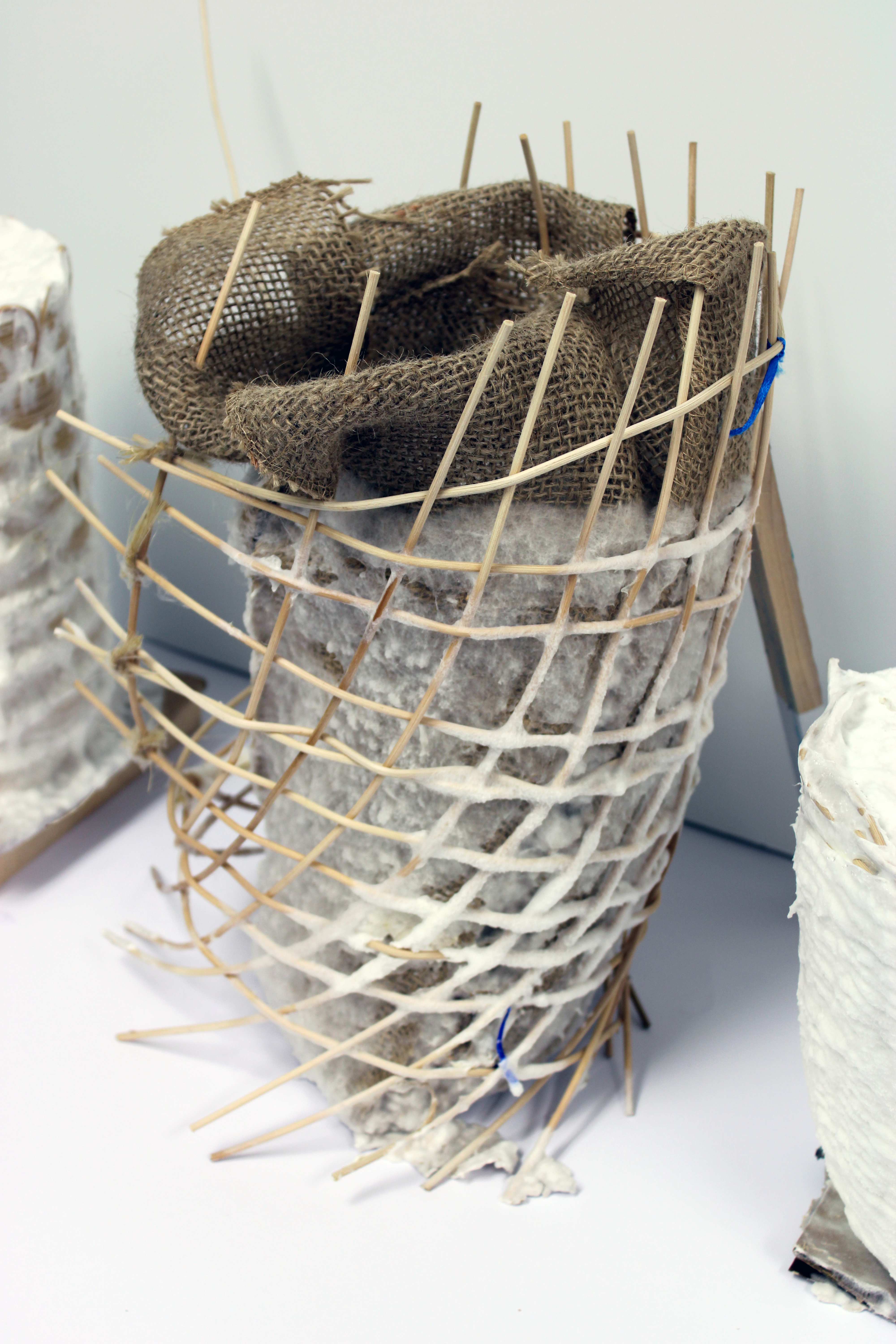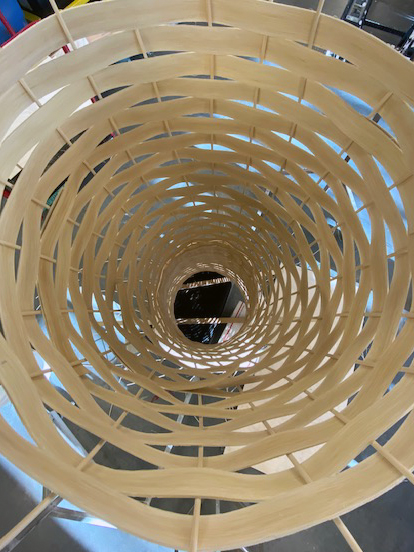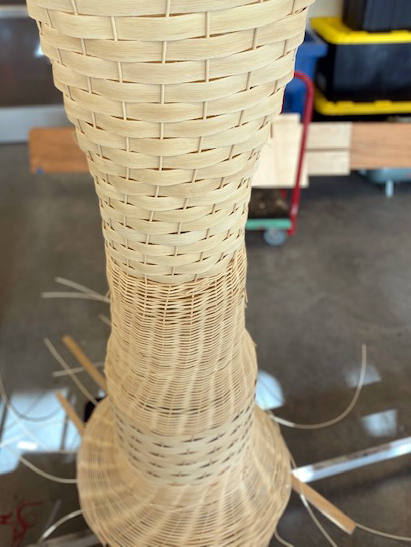Abstract:
During the 2021 semester, the MYCO MATTERS seminar built off the successes and failures of the Monolito Micelio Pavilion and grew performative "house parts" using fungi-based materials: a woven column, a spiral stair, and a screen wall. Over the course of the semester students in the seminar learned to grow myco-materials, to design and fabricate the molds and formwork needed for growing precise shapes for their assemblies, and participated in the invention of new construction systems needed to grow large-scale building components with myco-materials.
Funding was provided by the Kansas State University Global Food Systems (GFS) Seed Grant Program awarded to Profs. Jonathan Dessi-Olive, Richard Todd, and Vincent Amanor-Boadu.
The course ran in tandem to a series of web-based workshops and panel discussions titled “ResArch Lab: The Mycelium Project”.
Products of the seminar were published at the 2022 ICSA Conference.
Funding was provided by the Kansas State University Global Food Systems (GFS) Seed Grant Program awarded to Profs. Jonathan Dessi-Olive, Richard Todd, and Vincent Amanor-Boadu.
The course ran in tandem to a series of web-based workshops and panel discussions titled “ResArch Lab: The Mycelium Project”.
Products of the seminar were published at the 2022 ICSA Conference.
Graduate Seminar
Kansas State University Department of Architecture
Spring 2021

Myco-Weaves
In this context “Myco-weaves”, refers to the use of stay-in-place cellulose-based three-dimensional woven shell structures as a replacement for polymeric in-situ formwork and molds typically needed to grow myco-materials. While there are almost no active energy inputs needed to grow myco-materials, their reliance on plastics and molds that have limited reusability presents an ethical dilemma. Basket weaving crafts, are globally ubiquitous, formally flexible, and use natural materials that are readily available. They produce strong porous surfaces that allow contained myco-materials to breathe and provide a humid environment. Due to their lignocellulosic composition, basket woven surfaces also serve as a source of nutrition. In contrast to plastic formwork, myco-weaves encourage mycelia to grow into the formwork and integrate into the biomass. Woven formworks made with natural materials have the capacity to actively participate in the visual expression of building components made from myco-materials, and potentially strengthen the assemblies, serving as exo-skeletons. The woven formworks were prepared in advance and produced by hand using untreated caning reeds made from rattan. Such materials are procured rigid and dry, requiring them to be soaked in water to be pliable.
Translating preliminary tactical propositions into a more than 2 meter column structure required a custom loom. Templates were used to guide the subtle undulations of the diameter along the length of the column. In portions of the structure where the diameter was greater than 300mm, perforated cardboard tubes placed at the centroid of the assembly provided vital access to air. The tubes were sterilized, packed in the center of the column at the same time as the inoculated substrate, and expected to be partially consumed by the mycelium. A tarp was wrapped around the structure to provide a proper environment. Due to a contamination that occurred unexpectantly, the growth was stopped early using antiseptic spray. The top of the structure, where the contamination originated, was cut off.
STUDENT TEAM:
Zubair
Ahmed, Clayton Pfieffer, and Hudson Parris
![]()
![]()
![]()
![]()
![]()













Myco-Welding
Myco-welding involves growing living parts or blocks (typically in molds) and later assembling those living parts together into a desired form. Provided favorable growing conditions, the living parts grow into one-another to form a monolithic mass. The motivation to pursue this challenging technique in the context of residential building structures stems from the inherent challenges of in-situ monolithic mycelium.
The spiral stair was assembled as a series of identical living risers that were stacked and corbeled around a wooden post and grown into one another in-situ. Loose myco-material was used to level between blocks – as a brick or stone mason would with mortar. The individual modules were grown in CNC-milled EPS foam molds. Once carefully removed from their molds, the risers were let to grow for three days before being stacked and grown over several more days. Two myco-welding joints were achieved: between living parts, and between a partially dried part and a living part. Such phased construction was a practical response to monolithic mycelium which, like site-cast concrete, requires the material to be laboriously packed in the formwork. The process of stacking and staggering living stair-blocks gave rise to several challenges that were met with tactical responses. The blocks had to be assembled into a precise form and held for several days while they grew together. Furthermore, the form of the structure was stable when complete, but unstable during intermediate phases of assembly, causing the blocks to overturn, twist and potentially tear because living mycelium biomass is heavy with water-weight, and relatively fragile. The introduction of a wooden vertical support members which were measured in place and cut for each riser – highlighting that removable formwork materials and disposable molds are reusable to some extent, but still not avoidable. A large plastic tarp was used to provide an in-situ growing environment. Due to its size, the structure was air-dried, resulting in fruiting bodies growing from the structure.
STUDENT TEAM:
Emily
LaRocco, Zachary Jensen, and Justin Jennings

Myco-Sheets
The second iteration of Tactical Mycelium experiments were conducted at the School of Architecture at the Georgia Institute of Technology. Performed in the context of an experimental construction seminar available to Undergraduate, Graduate (MArch), and Post-Graduate (MS) students. The seminar consisted of several weeks of learning analytical and computational design techniques for compression-only structures. Observations made during the Mycoarch experiment were presented to the students as a prompt for a second tactical construction experiment with monolithic mycelium. Students were were tasked with designing a small monolithic mycelium structure that would be grown out of mycelium-stablized hemp, its internal formwork, and outer soft membrane schemes, for a volume of approximately 0.2 m3 of material from Ecovative.
STUDENT TEAM:
Roberto Bucheli, Keyhan Khaki, Sean Miller, Matt Singleton, Justin Wilson
Other Projects: